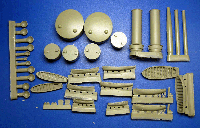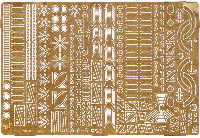| HISTORY |
|
|
(From Combrig Website) Poltava- named after the Battle of Poltava, built by the New Admiralty Yard in St. Petersburg, laid down in May 1892, launched in November 1894. She was commissioned in 1897 and was based at Port Arthur. The ship fought in the Battle of the Yellow Sea in 1904, but failed to escape and was sunk during the Siege of Port Arthur. She was subsequently raised and repaired by the Japanese and served in the Imperial Japanese Navy as the Tango. During World War I, she was returned to Japan's Russian allies in 1916, renamed the Chesma (after the Battle of Chesma), and transferred to the Arctic. She was captured by the British in Murmansk during the Allied invasion of northern Russia during the Russian Civil War, but damaged beyond repair. The wreck was scrapped in 1923.
From Wikipedia
This is the full hull version of Combrig's 1/350 Poltava kit. This kit is dated for Poltava's 1896 appearance, around the time of her initial commissioning. This kit comes in a thin cardboard box, with the parts well protected inside: both hull halves, two bags of resin parts, a fret of photoetch and the instructions.
|
|
|
|
|
| HULL PARTS |
|
|
The hull comes in two parts, upper and lower. Each are hollow cast, making for a lightweight resin hull, and saving on material costs. Both halves have molded on trim line to remove the resin overpour; the kerf of a razorsaw fits perfectly into this. They halves seem to line up nicely, and appear to be correctly scaled.
The upper hull is crisply cast, with defects to be seen. The hull sides have a graceful curve up to the finely scribed decks. The scuttles are all uniform in appearance, as are the various hatches on the hull. The admiral's walk is also nicely done.
The lower hull has a smoothly shaped ram bow, and clean lines throughout. There is a slight bilge keel running the length of most of the hull, nearly back to where the shaft skegs start. Like the upper hull, there are no blemishes or other casting defects apparent.
|
|
 |
|
|
| PARTS BAG A |
|
|
This first bag of parts contains a wide range of items. The large bridge platform cast on a wafer, with multiple bridges and funnel bases. There are two box-like bridges, but they are not identical. Since there are no part numbers, be careful you choose the correct bridge- the instruction illustrates the bridge with four windows.
A variety of resin sprues provide various parts to structures all over the ship; right and left handed propellers, the shaft supports and massive rudder, gun barrels (with solid muzzles), some delicate resin "J" davits, various searchlights and other deck details, and two well-executed, anchors. These anchors are a two-piece affair, with the detailed stocks separate from the shanks.
|
 |
|
|
| PARTS BAG B |
|
|
Parts bag B also contains a motley assortment of parts; cowl vents of various sizes, the six turrets of Poltava, the kingposts, funnels and the large selection of ship's boat, which includes a detailed steam launch.
Each of the turrets are smooth and clean, a hallmark of modern Combrig castings. The vents atop each turret are also well done.
|
 |
|
|
| PHOTOETCH |
|
|
There is a fret of photoetched brass included with this kit. This fret is not relief-etched, meaning the parts are two-dimensional prior to folding. This fret includes cradles for the ship's boats, anchor chains, ladders, and various stanchions and supports for the decks and platforms. Placing and aligning the stanchions could prove challenging.
As per standard Combrig practice, there are no railings included in this kit.
|
 |
|
|
| DECAL |
|
|
There are no decals included in this kit.
|
|
|
| INSTRUCTIONS |
|
|
There are four pages of instructions, two double-sided sheets, with a profile and plan view with history and specifications, graphic bill of materials, and two pages of exploded views. These are well drawn but are missing part numbers to identify the parts. There are no steps, breaking down construction. Time and study will be required to plan your build. Dimensions for trimming your own masts and yards are provided.
The painting instructions are text on the front page, nestled alongside the ship's history. Poltava's appearance changed over the years, so your color choices will be dependent upon the era selected.
|
|
|
| CONCLUSIONS |
|

As was mentioned about the turrets, but is valid about the entire kit; crisp, clean castings with sharp detail, Poltava exhibits all the hallmarks of what the name Combrig has come to mean in the ship modelling world. It's also an esoteric subject, which is another a hallmark of Combrig. It is encouraging to see they are expanding their offerings in 1/350
This kit is available for $160 for waterline and $190 for the full hull version. Check the Combrig site for details on where to get yours and for other new Combrig kits.
Thanks to Combrig for providing this review sample.
|


